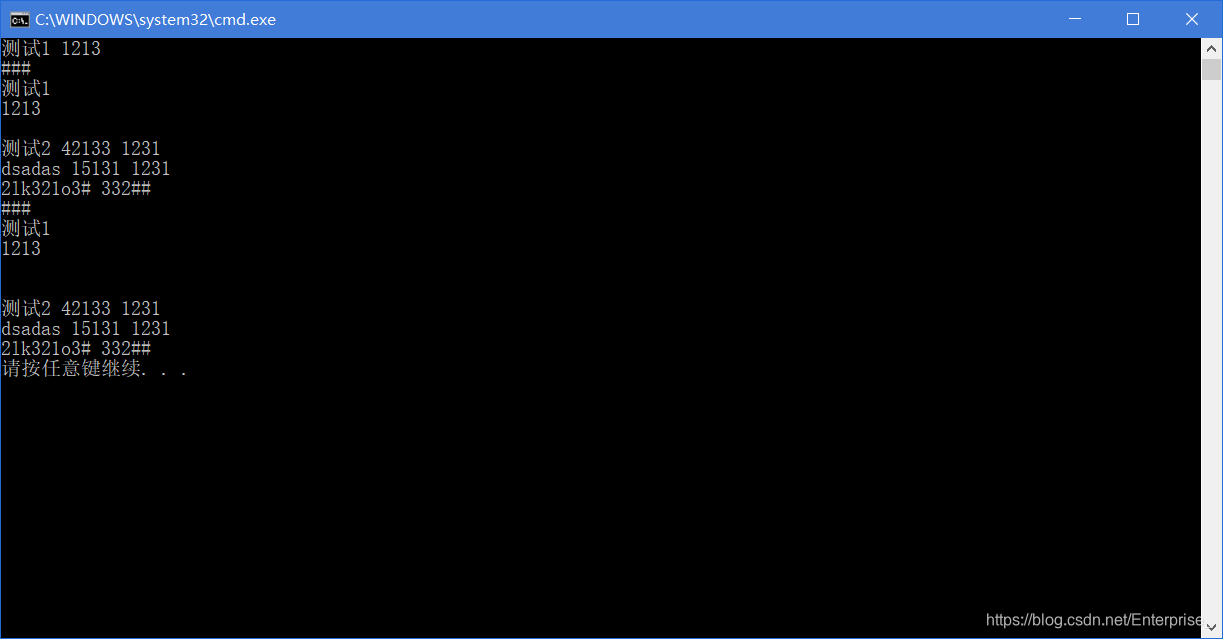版权声明:本文为博主原创文章,未经博主允许不得转载。 https://blog.csdn.net/Enterprise_/article/details/86644155
- iostream处理控制台IO
#include<iostream>
#include<string>
using namespace std;
istream& Test(istream &in) { //IO对象没有拷贝或者赋值,所以形参和返回值都不能设置为流类型,通常用引用来传递流对象。
string word;
while (in >> word && !in.eof()) {
cout << word << endl;
}
in.clear();
return in;
}
void TestCin(istream &in) {
int a = 0;
auto old_state = cin.rdstate(); //记住cin的当前状态
cin.clear(); //无参数clear,将所有条件状态复位
while (cin >> a) {}
cin.setstate(old_state); //将cin设置为原有状态
//只复位failbit和badbit位,其他不变
cin.clear(cin.rdstate() & ~cin.failbit & ~cin.badbit);
}
int main(void) {
cout << "a" << endl;//加入回车后立刻刷新
cout << "a" << ends;//加入空格后立刻刷新
cout << "a" << flush;//什么也不做立刻刷新
cout << unitbuf;//所以输出都立刻刷新,无缓冲
cout << "a";
cout << nounitbuf;//回到正常的刷新方式
cout << "a";
return 0;
}
- fstream处理命名文件IO
#include<iostream>
#include<fstream>
#include<string>
#include<vector>
using namespace std;
vector<string> str;
vector<string>::iterator it;
string tmp;
void printline(string ifile) {
ofstream out; //未指定文件打开模式
string word;
out.open(ifile + ".txt", ofstream::app); //设置文件打开模式为app追加模式
while (getline(cin,word) && word != "###") //读入一行
out << word<<endl; //写入文件
out.close();//关闭文件流
}
void printone(string ifile) {
ofstream out; //未指定文件打开模式
string word;
out.open(ifile + ".txt", ofstream::app); //设置文件打开模式为app追加模式,实际上隐含了out模式,仅以out模式打开文件会丢弃原有数据
//上述效果等价于out.open(ifile+".txt),ofstream::out | ofstream::app);
while (cin >> word && word != "###") //读入一个
out << word << endl; //写入文件
out.close(); //关闭文件流
}
void readone(string ifile) {//将文件内容读入到一个string的vector容器中
str.clear();
ifstream openfile(ifile+".txt",ifstream::in); //以读模式打开一个文件
while(openfile >> tmp) { //没有到达文件的尾部
//读入一个
str.push_back(tmp); //每个元素单独存入vector中
}
if (str.empty()) { //没有数据,直接返回
cout << "No data?!" << endl;
return ;
}
it = str.begin();
for (; it != str.end(); it++) //输出文件内容(存入vector中)
cout << (*it) << endl;
openfile.close(); //关闭文件流
}
void readline(string ifile) {//将文件内容读入到一个string的vector容器中去
str.clear();
ifstream openfile(ifile + ".txt", ifstream::in); //以读模式打开一个文件
while (getline(openfile, tmp)) { //没有到达文件的尾部
//读入一行
str.push_back(tmp); //每一行作为独立元素存入vector中
}
if (str.empty()) { //没有数据,直接返回
cout << "No data?!" << endl;
return;
}
it = str.begin();
for (; it != str.end(); it++) //输出文件内容(存入vector中)
cout << (*it) << endl;
openfile.close(); //关闭文件流
}
int main(void) {
printone("1");
readone("1");
printline("1");
readline("1");
return 0;
}
- 读入过程

- 文件写入后的txt

- stringstream完成内存string的IO
#include<iostream>
#include<sstream>
#include<string>
#include<vector>
using namespace std;
int main(void) {
ostringstream os;
os << "dad";
string as = os.str();
string bs = "1213213";
os << bs;
cout << as << endl;
as= os.str();
cout << as << endl;
//如果构造的时候设置了字符串参数,那么增长操作的时候不会从结尾开始增加,而是修改原有数据,超出的部分增长
ostringstream temp("1");
cout << temp.str() << endl;
temp << "dsadas"; //修改原有数据后追加字符串
string t1 = temp.str();
cout << t1 << endl;
os.clear();//如果需要使用同一个流,每次使用之前都需要clear一下
int a = 15216;
stringstream ans;//int转字符串
string b;
ans << a;
ans >> b;
cout << b << endl;
return 0;
}

4. 总结
类fstream和stringstream都是继承类iostream的,输入继承istream,输出继承ostream,所以能都使用istream的地方都可以使用ifstream和istringstream,对ostream同理。